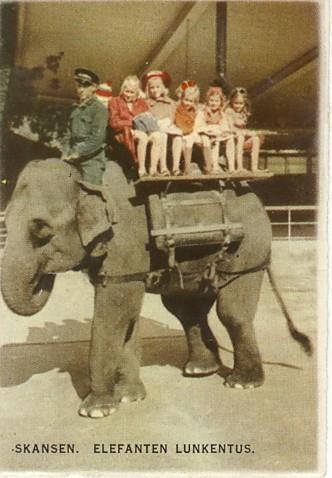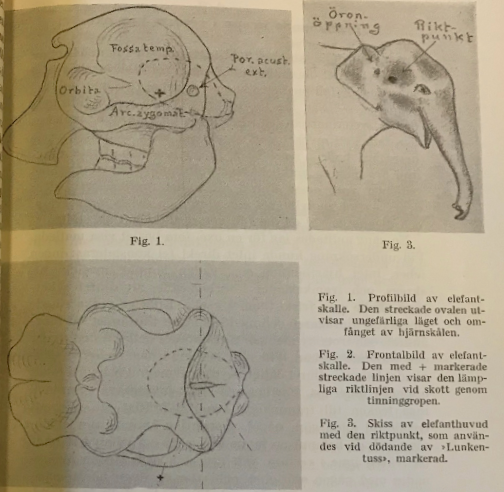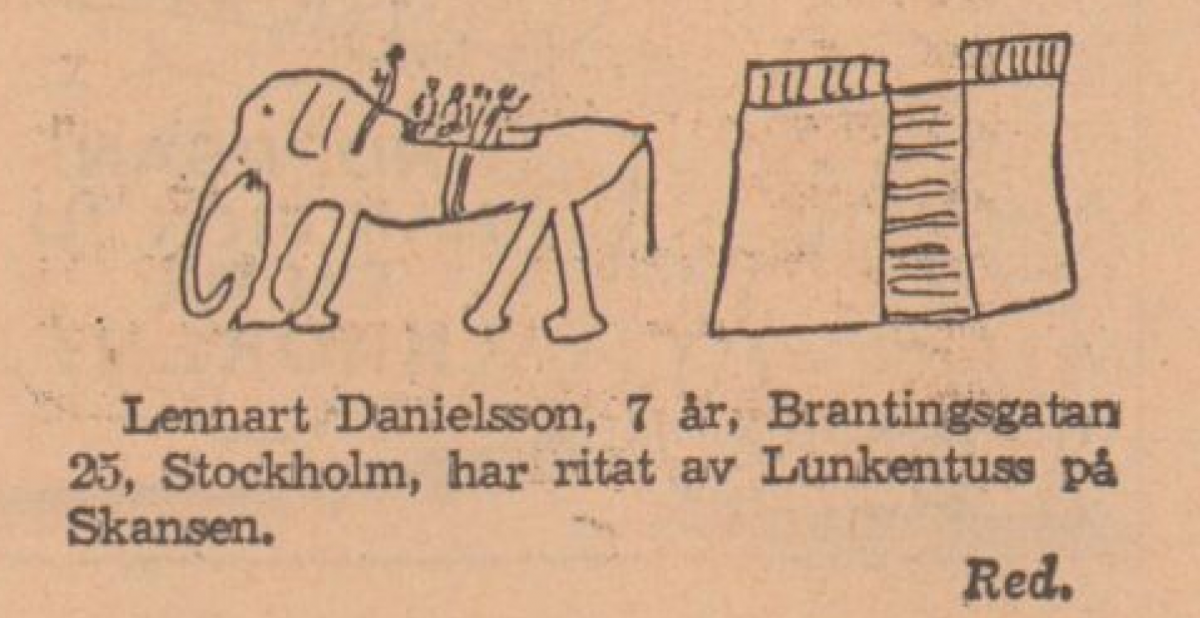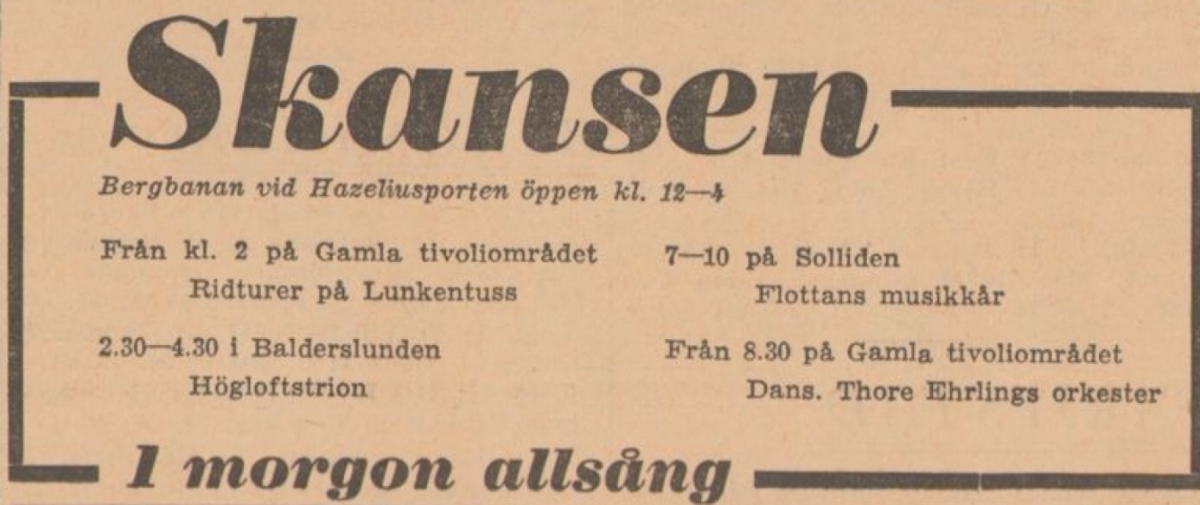Post written by Karl Bruno, postdoc at the Division.
The Division’s kickoff at Skansen this year gave opportunities to reflect on the institutional combination of open-air museum and zoological park that this location embodies. The keeping of Nordic animals can be understood historically as part of the same identity-building project as Skansen as a whole, representing Swedish nature similar to how the collected buildings represent Swedish culture. However, other animals are there too, and have been almost since Skansen opened. From monkeys to turtles, penguins, and walruses, exotic animals have always been big attractions, important to the economy and strategy of the park. The presence of a range of animals in the center of the capital also means that Skansen has long been a site for the creation and mediation of animal-related knowledge. Only a few days after the kickoff, I stumbled on a curious account in the archives that highlight both these aspects of Skansen’s history. We might call it “The Illness and Death of Lunkentuss the Elephant.”
Lunkentuss (née Rani) was an Indian female elephant born in the 1920s and bought by Skansen in 1931. She was the first elephant Skansen owned—following a highly successful experiment with a borrowed one—and became a very popular exhibit. She drew large crowds, particularly in the warm season when children were able to ride the compliant and docile animal around the grounds. But already in 1938, when still very young by elephant standards, Lunkentuss began to show slightly impaired movement in her right hind leg. Fearing for the future of its crowd-pleaser, Skansen brought in its consulting veterinarian Vilhelm Sahlstedt, professor of chemistry and physiology at the Royal Veterinary College.

Confronted with Lunkentuss, Sahlstedt faced several problems that required the adaptation of established practices and the development of new knowledge. He initially knew little of elephants from a clinical perspective. The detailed leg examination that would be carried out on horses with similar symptoms could not be performed on Lunkentuss, as her leg was too big. Resorting to observation and extending what he knew of the movement of horses and other big mammals, Sahlstedt nevertheless was able to conclude that she was suffering from an inflammation of her knee joint and proceeded to treat her accordingly, with local and internal application of salicylates. At first Lunkentuss refused the medication, but Sahlstedt found that by placing it in a “piece of bread or some suitable root vegetable” she would eat it. The therapy took effect; Lunkentuss could once again carry children around. The leg problems periodically reoccurred, but repeated treatments ensured that she continued to serve as a central attraction at Skansen.
In the fall of 1939, Lunkentuss’ general condition worsened. She would eat less, now showed symptoms of pain in both hind legs, and resisted her normal exercise. Sahlstedt was recalled but again the body of the elephant resisted the application of normal clinical techniques. Auscultation was possible, but revealed nothing remarkable; palpation was not—the skin was too thick and the animal simply too voluminous. Though at a loss for a diagnosis, Sahlstedt tested a pharmaceutical treatment based on small doses of arsenic. This stimulated Lunkentuss’ appetite, but her condition did not improve and she grew increasingly thinner. She continued to draw crowds, but after the spring of 1940 could no longer be used for rides. In early 1941, conceding that she was unlikely to improve and with the state of her legs deteriorated to the point that it was impossible to exhibit Lunkentuss outside of her stables, Sahlstedt finally proposed to put the animal down.
With that, however, another significant problem arose. No one knew how to best dispatch an elephant. It seemed clear that a rifle had to be used, but since elephants have very large skulls but not very large brains, it was difficult to determine where to place the shot. The veterinary literature Sahlstedt consulted provided only vague hints, and a search for big-game hunters (who were presumably knowledgeable in such matters) failed to locate one in Stockholm. Rash experiments were out of the question, not only for humanitarian reasons but also because Lunkentuss was a well-known and charismatic animal that many people had a relation to. A botched killing might thus end up in the press, which would be a public relations nightmare. Eventually, however, Sahlstedt came up with an innovative approach: he approached the Museum of Natural History and, together with one of its curators, made measurements on elephant skulls from the museum collections. From these, Sahlstedt concluded that the killing shot should be placed in the fossa temporalis at the side of the skull from a certain distance and angle. A special hunting rifle was then acquired from the Huskvarna works and its penetrative power with different kinds of ammunition was tested by firing on sets of pinewood planks. When sufficiently satisfied both with his anatomical investigations and with the weapon, Sahlstedt had Lunkentuss immobilized and marked the aimpoint with paint on her head. Chief Animal Handler Johansson, known to be a good shot, was tasked with carrying out the killing. On February 17, 1941, he proved Sahlstedt’s calculations correct. Squarely hitting the intended point, Lunkentuss died instantaneously.

The story of Lunkentuss points to a history of Skansen in which exotic animals were important actors playing active parts in making the park what it was, even as the park made them what they were. While healthy, Lunkentuss generated much publicity and revenue. She became something of a symbol of the park, who, as she trudged around the pathways with kids on her back, acted out a defining experience of a Skansen visit. As a sick animal, her victimization and commodification becomes clearer, in a way that highlights how the story is also of the construction and nature of veterinary expertise.

Because Sahlstedt had little theoretical or practical experience of elephants, his encounter with Lunkentuss triggered experimental and investigative work that created new knowledge of their lives and deaths. He learned how to treat their knee joints, how to feed them medicine, how they could and could not be examined clinically, and ultimately also—by enrolling the Museum of Natural History and its collection of already-dead elephants—how to kill them. He published an account of these findings in a veterinary journal, arguing that they might be useful for his colleagues if, for example, they were consulted by elephant-keeping circuses. Part of the motivation was perhaps also pride in his innovative application of anatomical expertise to the skulls from the Museum of Natural History, generating new knowledge of clear practical value.
But Sahlstedt’s expertise only took him so far. The final nature of Lunkentuss’ illness eluded him. He was then faced with a tension central to all veterinary practice, emerging from the fact that patients and clients are not only distinct, but the former are also the property of the latter and their interests need not overlap. In the case of Lunkentuss, Skansen’s interest in keeping a key attraction alive had to be balanced against the fact that Lunkentuss was in pain but could not be diagnosed nor efficiently treated. Sahlstedt’s own account of the affair—which is also the basis of my narrative—can in part be read as a defense of his management of this tension, particularly his decision to wait a rather long time before finally having the animal put down. Though Lunkentuss was not healthy, he argued that she still retained some appetite and seemed “lively and interested in her surroundings,” a behavior that did not suggest great suffering. Balancing her value for Skansen against the perhaps only light pain she was experiencing, Sahlstedt thought his wait-and-see approach justified until there really was no more hope for improvement. This medical judgement was to Skansen’s advantage. It did not make Lunkentuss’ condition public and the ailing elephant continued to be used for publicity and in advertisements through 1940. When announcing her death, Skansen suggested that she had acutely taken ill, a claim that was reproduced by the press and has also shaped later accounts of Lunkentuss’ life (these sometimes include the claim that the cause of her illness was the accidental ingestion of broken glass, a theory not mentioned by Sahlstedt nor, apparently, supported by the autopsy performed at the Veterinary College). This obscured and obscures the fact that the animal was in fact chronically ill and under veterinary care for three years before she was killed.

Advertisement for Skansen printed in Svenska dagbladet, May 27, 1940, offering rides on Lunkentuss. She was already unwell by then and lost the ability to perform this task soon after.
It is understandable that Skansen preferred to keep quiet about Lunkentuss’ long illness, since being a very public animal, the way she was treated had the potential to impact strongly on the public appreciation of the park. The veterinary expertise involved was likewise at risk of public scrutiny. Sahlstedt, who had been the vice-chancellor of the Veterinary College and was in some respects a professional leader, was not insensitive to this. In his account, he reflected that fair or not, a veterinarian had “to be prepared to be asked almost anything that has to do with animals,” no matter the particular animal’s prevalence in Swedish veterinary practice. This goes some way to explain the care he took in giving Lunkentuss a painless death: Sahlstedt noted twice in his account that it was instantaneous, a wording that also recurs in the press coverage (presumably reflecting a Skansen statement). It suggests something of how the fate of Lunkentuss was not only closely bound up with the construction and nature of veterinary expertise, but also with its mediation and how it self-consciously dealt with an unusually public patient.
Finally, Lunkentuss also highlights the importance of historical attention to the agency of animals and to human–animal interactions. Lunkentuss’ own behavior and actions were constitutive of the role she came to play at Skansen, as well as of the development of veterinary knowledge of and around her. It was her compliance with her handlers’ instructions and her docile nature when interacting with visiting children that created the position she acquired in the zoo and thus also many people’s image of Skansen. When she began resisting certain interactions (feeding, exercise), veterinary expertise was brought in, creating new forms of interaction that enabled new knowledge development. This is not to say that there was symmetry of power: Lunkentuss was subject to human action over which she had limited control. But she retained her ability to express experiences and act in a range of ways that all influenced the dynamics of interaction between herself, her handlers, riding children, and the veterinarian—and by extension she thus also shaped the interaction between Sahlstedt, Skansen, and the general public. In this respect, Lunkentuss illustrates the importance of exploring the past lives of animals, as we might find that the way in which these lives were lived impacted on a wide range of developments otherwise thought of as human-driven.
Even Lunkentuss’ final interaction with Chief Animal Handler Johansson is of historical significance. The immobilized and marked elephant had little influence left by then—but the successful killing validated the expertise that had been created around Lunkentuss’ illness and death. Unlike a botched attempt, Sahlstedt’s aimpoint and Johansson’s shot served to confirm that Skansen could take responsibility for elephants in life and in death. Consequently, another young elephant, Bambina, could simply take Lunkentuss’ place, and elephants would continue to draw crowds to the park until 1992.
The account is primarily based on, and all quotes (translations by me) are from, A. V. Sahlstedt, “Från Skansens zoologiska trädgård: En elefants sjukdom och död,” Svensk veterinärtidskrift 46, no. 4 (1941). I have also reviewed press material from 1939, 1940, and 1941 in the Royal Library.
This blog post hints at perspectives and approaches I will work with—albeit in an agricultural rather than an exhibition context—in my new project at the division. Entitled “Clinical Breeding: Cattle Reproduction and Veterinary Expertise in Sweden, 1922–1975,” the project will examine the co-production of human–animal relations, veterinary expertise, and reproductive technologies in the context of mid-twentieth century Swedish dairy farming. I will spend two years of the project as a visiting researcher at the Centre for the History of Science, Technology & Medicine, King’s College London.
Further reading:
An excellent book on elephants as actors in the context of American circus is Susan Nance, Entertaining Elephants: Animal Agency and the Business of the American Circus (Baltimore: Johns Hopkins University Press, 2013)
The longer history of Skansen’s elephants is detailed in Ingvar Svanberg, “Indian Elephants at Skansen Zoo,” The Bartlett Society Journal 21 (2010).
For a brief overview of the “animal turn” in history (including a short bibliography), see Dan Vandersommers, “The ‘Animal Turn’ in History,” https://www.historians.org/publications-and-directories/perspectives-on-history/november-2016/the-animal-turn-in-history


Interesting with this new information regarding the death of Lunkentuss. Here is her record in my global database of elephants with aphoto of her cranium, unfortunately from the wrong angle… https://www.elephant.se/database2.php?elephant_id=61
Hi Dan, thanks for your comment and the link to the database! I didn’t realize that Lunkentuss’ cranium too was incorporated in the Natural History Museum’s collections – that adds an interesting extra layer to the story.